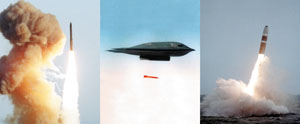In 1988, just before the Cold War faded out, America’s strategic nuclear deterrent boasted some 13,000 warheads, but two subsequent decades of negotiated cuts have reduced the total to roughly 2,000 “operationally deployed” weapons.
Warhead losses of such magnitude inevitably have rippled through the fleet of delivery vehicles built to carry the weapons to targets. Entire categories have vanished. Remaining types are fewer in number and fitted with smaller weapon loads.
 |
By (in order) land, air, and sea. |
To date, no US Administration has ever seriously considered abandoning the “triad” of land-based ICBMs, bombers, and missile-firing submarines. Its continuation, however, is no longer the stone-cold, lead-pipe cinch that it once was.
Secretary of Defense Robert M. Gates said change could emerge from the current Quadrennial Defense Review and new arms talks with Russia. “If we go down significantly in the number of nuclear weapons that we have deployed, the question is whether the traditional triad makes sense anymore,” he said in remarks at Maxwell AFB, Ala.
Since late 1960, when the strategic submarine force went operational, 11 Presidents and 16 Pentagon chiefs have supported the triad concept. The reason is simple: US bombers, ICBMs, and submarines each offer distinct benefits. Moreover, the whole is greater than the sum of its individual parts.
True, as you draw down the total numbers of warheads, the triple-headed system of delivery systems—at some point—becomes untenable. In the most extreme example, a nuclear weapons inventory of two warheads can’t be split three ways.
So somewhere between 2,000 weapons and two weapons lies the lower limit of a minimum deterrent triad force. Few have offered any near-term justification for eliminating a leg of the triad for anything other than reasons of economy, however.
The bombers were the original nuclear delivery systems. Although both nuclear cruise missile and bomber numbers have declined in recent years, the Air Force is bolstering its nuclear bomber mission. USAF is reorganizing its B-52 inventory, settled on 76 of the jet aircraft as the correct number, and is standing up a fourth B-52 combat squadron. One B-52 unit will dedicate itself to the nuclear mission at all times.
Bombers offer unique benefits. They are highly visible symbols of intent if they are put on ground or airborne alert, sent overseas, or dispersed to various US bases. They send a clear message that the US is taking a threat or incident seriously. Further, the bombers are highly accurate and they alone can be “recalled” after launch.
Nuclear gravity bombs remain an important part of the US arsenal—the B-2 and B-52 can deliver B61 and B83 strategic bombs.
The B-52 can also launch the nuclear-tipped Air Launched Cruise Missile. The ALCM will become the sole US air-launched strategic missile once USAF completes deactivating the Advanced Cruise Missile.
The ICBM force has seen a similar force drawdown. The US retired its 50 Peacekeeper missiles with 500 warheads some years ago. It has more recently cut the Minuteman III inventory from 500 to 450 systems. At least 150 of the remaining ICBMs have been “downloaded” from three warheads to single weapons.
The Air Force has a comprehensive Minuteman modernization plan in place because these missiles offer their own unique benefits. There is undeniable value in a weapon that can destroy a target anywhere in the world in about 35 minutes.
The ICBM inventory also serves to discourage nuclear competition. Roughly 500 missile silos and launch control centers are spread across hundreds of miles of US soil. An enemy seeking a pre-emptive attack on the US nuclear force would likely have to target every silo and launch control site with two weapons to have a reasonable expectation of destroying them. The fact that two nukes would likely be expended attempting to destroy single-warhead Minuteman IIIs also makes such an attack costly and inefficient.
Finally, the Navy’s Ohio-class Trident submarines are generally regarded as the most secure leg of the triad because, when submerged, they are extraordinarily difficult to detect. Though there are just two Trident sub bases, at Bangor, Wash., and Kings Bay, Ga., the boats have all the world’s oceans in which to roam.
For the foreseeable future, the boomers are secure, but depending solely on submarines for nuclear deterrence is a risky long-term proposition. A revolution in anti-submarine technology, ballistic missile defenses, or a major equipment failure could someday make the undersea deterrent vulnerable.
The boomers have also seen their numbers decline. Because each boat could carry 192 nukes (eight warheads atop each of 24 SLBMs), the 2001 Nuclear Posture Review and subsequent Moscow Treaty led to a reduction from 18 to 14 Trident subs, while the D5 missiles themselves had warheads downloaded.
Ultimately, by preserving each leg of the triad, the US maintains unique capabilities, complicates enemy attack and defensive options, and is protected against a failure in one of the systems. As long as nuclear weapons remain key instruments of national military power, policy-makers would be wise to attempt to preserve the diversity of the triad.
More information: http://www.usip.org/resources/americas-strategic-posture
